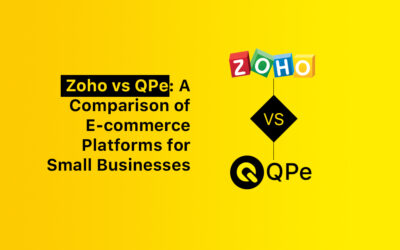Did you know most of the luxury shoppers prefer brands with a strong online presence?
To launch a luxury clothing brand, you need to curate an experience of elegance, exclusivity, and quality that separates your brand from the competition. To attract elite buyers, luxury fashion focuses on timeless style and superior craftsmanship.
Every detail counts, whether you’re sketching ideas or finalizing your designs. Your brand identity, a seamless online platform, and the ability to highlight your uniqueness will help you succeed in this competitive industry.
Luxury fashion is a competitive industry, so you need a platform to help you stand out. Here’s where QPe comes in.
With QPe, you can create a premium online store that reflects the sophistication of your brand. Its no-code capabilities, customizable templates, and seamless integrations make it easy to showcase your collections beautifully.
QPe also simplifies your e-commerce journey with automated marketing, effortless inventory management, and affordable, scalable solutions. Focus on growing your brand while QPe handles the tech side.
As you develop your brand identity, this guide will help you discover the right platform for showing off your designs.
What is Brand Identity?
Brand identity is all about how a company shows itself to the world. It includes the tools and elements that shape how people see the brand. It tells you what the company stands for, its values, mission, and goals. Done right, it helps build trust, loyalty, and makes the brand easy to recognize.
Key Elements of Brand Identity:
- Brand Name: The foundation of the brand’s recognition.
- Tagline or Slogan: A short, memorable phrase that communicates the brand’s core message.
- Logo and Wordmark: Visual symbols that represent the brand.
- Colors and Graphic Styles: Create a distinct and cohesive visual appearance.
- The tone of Voice: Defines how the brand communicates in words.
- Typeface and Style: Reflects the brand’s personality in text form.
These components work together to:
- Create a cohesive image that distinguishes the brand.
- Help customers remember and connect with the brand.
- Align with the values and interests of the target audience.
Brand identity serves as a bridge between what the company stands for and how it wants to be perceived.
Characteristics of a Luxury Clothing Brand
Luxury clothing brands set themselves apart with unmatched quality, exclusivity, and timeless appeal.
-
Focus on High-Quality Craftsmanship
Luxury brands create garments with precision and attention to detail, ensuring every piece is perfect.
-
Use of Premium Materials
They choose the finest fabrics, like silk, cashmere, and sustainably sourced textiles, for unmatched quality.
-
Offer Limited-Edition Collections
Several luxury clothing brands produce exclusive pieces that are highly sought after.
-
Deliver Personalized Experiences
From custom fittings to customized designs, these brands offer services that cater to individual preferences.
-
Maintain a Strong Brand Identity
Luxury brands have iconic logos, patterns, or designs that make them instantly recognizable.
-
Blend Tradition with Modern Innovation
They honor their heritage while incorporating modern styles and technologies to stay relevant.
-
Embrace Sustainability
Sustainable materials and ethical production methods are used by luxury brands.
-
Provide Exceptional Customer Service
They focus on making every interaction special, from private shopping to after-sales support.
-
Create Timeless Designs
Luxury clothing is not about fleeting trends but about creating pieces that remain stylish for years.
-
Inspire Aspirations
Luxury brands position themselves as symbols of success and sophistication, making their products highly sought after.
These traits make luxury clothing more than fashion, they are a lifestyle statement.
How To Create A Business Plan For A Luxury Clothing Brand
Are you thinking of starting a luxury clothing brand? You need a clear plan that covers the big stuff. Let’s break it down into three simple steps:
1. Identify Your Target Audience
To sell luxury, you have to know who’s buying.
- Who They Are: Wealthy people who care about exclusivity and quality. Look at their age, lifestyle, and income.
- Why They Buy: It’s not just about clothes. They’re buying status, craftsmanship, and something unique.
- Types of Buyers:
- Aspirational Buyers: People who love luxury but don’t buy it all the time.
- Core Buyers: Regular luxury shoppers with disposable income.
- Elite Buyers: Those who want custom, limited-edition pieces.
- Do Your Research: Check what these groups love, how they shop, and what keeps them loyal to brands.
2. Plan Financials For Premium Pricing
Luxury isn’t cheap, and neither is running a brand.
- Figure Out Costs:
- High-quality fabrics and details.
- Skilled labor for production.
- Branding, marketing, and retail setup.
- Price It Right: Don’t aim to compete on price. Luxury is about perceived value, so set prices that reflect that.
- Aim for High Margins: Your profits should be at least 2–5 times your production costs.
- Plan Investments:
- Design and production costs upfront.
- Setting up stores or an online shop.
- Marketing campaigns to get noticed.
- Know Your Break-Even Point: Figure out how much you need to sell before you start seeing profits.
3. Set Long-Term Brand Goals
Luxury brands are built to last, so think ahead.
- Your Vision: What’s the big dream? Maybe it’s redefining luxury with eco-friendly practices.
- Your Mission: How will you make it happen? Focus on what makes your brand stand out, like unique designs or sustainability.
- Plan Milestones:
- Launch your first collection.
- Open stores in luxury hotspots like Paris or New York.
- Build a strong online presence.
- Sustainability Goals: More luxury buyers care about ethical practices. Use eco-friendly materials and keep waste low.
- Customer Loyalty: Keep clients hooked with personalized services, exclusive collections, and top-notch experiences.
Marketing Strategies For a Luxury Clothing Brand
If you’re building a luxury clothing brand, you know exclusivity is everything. The trick is making people feel like they’re stepping into a world they want to belong to. Here’s how to pull that off:
1. Utilize Social Media To Build Exclusivity
Your online presence should scream luxury. Here’s how:
- Private Communities: Start exclusive invite-only groups on Instagram or Facebook. It’s like a VIP lounge, but online.
- Teasers and Drops: Share sneak peeks of limited-edition pieces or behind-the-scenes moments. Build that “I need this before it’s gone” feeling.
- Aesthetic Visuals: Invest in stunning photos and videos. Think dream settings, flawless lighting, and luxury vibes.
- Choose the Right Platforms: Focus on Instagram and Pinterest.
They’re all about visuals and staying trendy.
2. Partner With Influencers And Celebrities
People trust people they admire. Use that to your advantage.
- Celebrity Collabs: Partner with celebrities who get your brand. Red carpets, exclusive launches, you name it.
- Micro-Influencers: These folks have smaller but super-loyal audiences. Perfect for keeping things authentic.
- Luxury Ambassadors: Pick a handful of influencers or celebs to represent your brand long-term. Build those deep partnerships.
- Capsule Collections: Design exclusive pieces with influencers or celebs. It’s a win-win for both of you.
3. Craft Compelling Content For Storytelling
Luxury isn’t just about products. It’s about feelings, memories, and identity. So, tell stories.
- Share Your Heritage: Talk about your brand’s journey, craftsmanship, and what makes your pieces truly one of a kind.
- Feature Customers: Highlight how your clothing fits into their luxurious lives. Real people, real stories.
- Create Video Magic: Make ads or short films that don’t just show products, they show dreams and emotions.
- Seasonal Themes: Tie your campaigns to moments people care about holidays, cultural events, or even just the vibe of summer or winter.
Luxury is all about making people feel like they’re part of something extraordinary. Let them experience your brand, not just buy it.
Challenges in the Luxury Market
Luxury brands compete fiercely today. As iconic names, trends, and fashions change, it can be difficult to remain exclusive while growing.
Here are some tips on how to overcome the challenges.
1. Manage Competition From Established Brands
Big luxury names come with loyal fans and decades of reputation. Competing against them? It’s not an easy task.
Solutions:
- Highlight what makes you different, craftsmanship, sustainability, or bold innovation.
- Use laser-focused marketing to attract niche audiences.
- Partner with influencers to expand your reach and build trust.
2. Balance Exclusivity And Accessibility
How do you stay high-end while reaching more people? If you’re too available, you risk losing your prestige.
Solutions:
- Launch limited-edition products to keep demand high.
- Create sub-brands or affordable lines without diluting your luxury image.
- Use selective stores or online platforms to stay exclusive.
3. Adapt To Market Trends Without Losing Identity
Trends like sustainability or tech-savvy designs are big, but following them blindly can drive away loyal customers.
Solutions:
- Only adopt trends that match your brand’s core values, like eco-friendly materials or smart technology.
- Use storytelling to connect trends with your brand’s heritage.
- Actively listen to customer feedback to find the perfect balance between old and new.
Conclusion:
Fashion designers don’t just make beautiful designs when they start their luxury clothing line. Create an experience that attracts high-end buyers and builds a brand that lasts. Every step matters, your identity, your story, and your attention to detail.
You need a platform that matches your vision. QPe can help with that. You can create a stunning online store using no-code tools, customizable templates, and automation. In addition to handling the creative side, QPe will handle the technical side.
Luxury is about leaving a legacy. QPe helps you build yours.
Ready to start? Schedule a demo and see how QPe can simplify your e-commerce journey.
Frequently Asked Questions (Faqs):
-
How To Source High-Quality Materials For Luxury Fashion?
Build relationships with specialized mills and suppliers known for premium fabrics and focus on certifications like GOTS or OEKO-TEX for ethical and sustainable sourcing.
-
What Retail Strategy Works Best For Luxury Clothing Brands?
Integrate an online experience with exclusive physical stores in high-end locations to create scarcity and prestige for your brand.
-
How To Find Suppliers For Luxury Clothing Manufacturing?
Verify suppliers with samples, certifications, and ethical compliance through luxury fashion trade shows and platforms like Makers Row or Alibaba.



